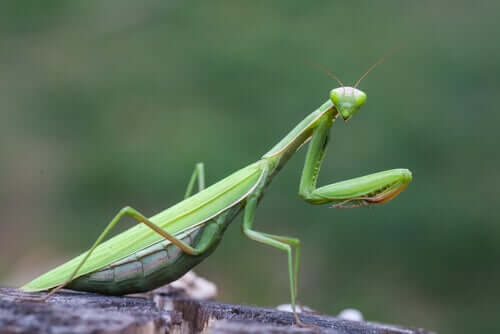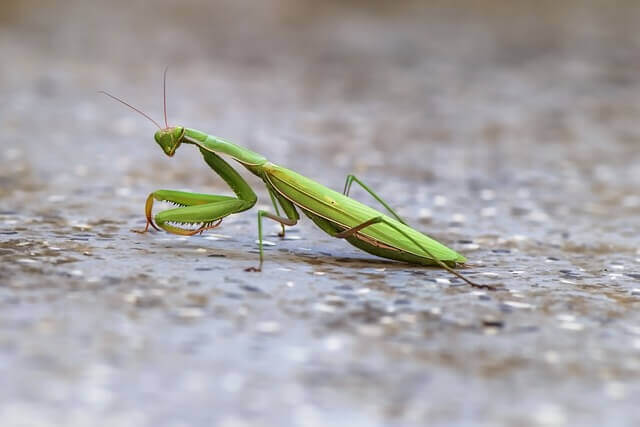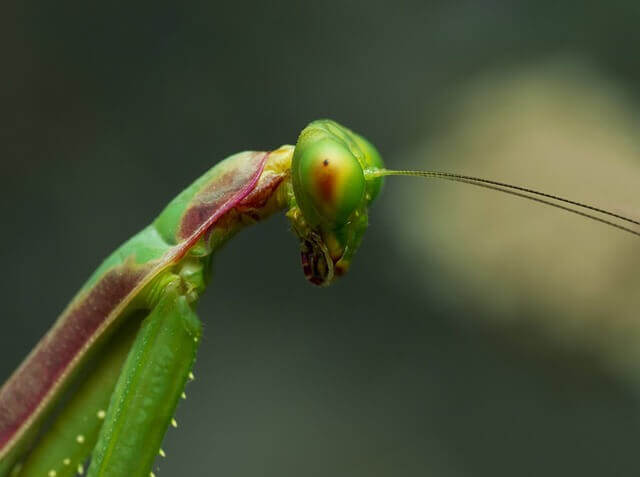The Praying Mantis: Characteristics, Behavior, and Habitat

The praying mantis is a medium-sized insect that possesses many interesting esthetic qualities. The unique positioning of its front legs makes the bug appear as if it were praying, making it especially recognizable and well-known. You can find the praying mantis not only in the wild but also as an exotic pet in some homes.
Though most people are familiar with the praying mantis, very few know how much diversity there is among this insect order. In fact, there are 2,400 species of mantises, about 430 genera, and 15 families. What’s more, the fact that their closest relatives are cockroaches and termites is also likely to surprise you.
The characteristics of the praying mantis
The praying mantis is an insect that measures between 4 and 4 3/4 inches long. It’s worth pointing out that females tend to be larger than their male counterparts. They have a long thorax and two long antennae that come out of their heads.
The most distinctive feature of the mantis has to do with its front legs. These legs are in a praying position, as we explained before, which explains the common name for these insects. What’s more, their legs have spines which help them trap and hold onto their prey.
The color of the praying mantis depends on the environment where it last changed its skin. Coloration can vary from green to brown, and the purpose is to help the insect camouflage itself.
In other words, if the molting occurs in an area with lots of grass, then the mantis will be green. However, if there is a lot of chaff or straw in the area where a mantis molts, then it will be brown. Thanks to this adaptability, the praying mantis can blend into its environment very well… making it difficult to spot.

Life expectancy
The life expectancy of the praying mantis is approximately one year. Within this time period, they shed their skin 6 times in order to reach their full adult size. They hatch from legs which female mantises lay by the hundreds. And when they’re young, they have the same appearance as adults–but at a much smaller scale.
Contrary to what many people believe, the praying mantis is not poisonous and doesn’t even bite humans. What’s more, mantises can help control certain insect plagues in open spaces. So, rather than being a dangerous pest, having a mantis in your garden is actually quite beneficial.
Behavior
The mantis is a carnivore and a very patient predator. It’s able to wait for its prey while remaining completely still and then attack its target quickly and completely by surprise.
In fact, a study affirms that the praying mantis hunts small birds–such as the hummingbird–much more than we think. Furthermore, they hunt using their powerful front legs which move at a speed that imperceptible to the human eye. In an instant, they extend these legs and trap their prey in their spikes.
Mantises are solitary insects that normally tend to live independently. They only unite with other mantises in order to mate and, if two or males meet, they will fight to the death. Only the victor will be able to mate. However, some females mantises actually eat the heads of males after they are finished mating. Fortunately for the males, this behavior is less common than many believe.
Habitat
The praying mantis comes originally from Europe and Asia and was introduced artificially in North America by man. Today, you can find them all over Europe, the upper two-thirds of Asia, and almost all of North America. What’s more, there are some areas of central Africa and the most southern part of South America where you can also spot them.
The mantis is a field insect that often lives in gardens, pastures, and places with little human presence. It’s definitely not an insect you’re going to find strolling around the city. Rather, it much prefers being able to hide among the grass, leaves, and tree branches. Only this way can the praying mantis take advantage of its surroundings to await its prey.

The mantis as a pet
As we mentioned before, the mantis falls into the category of a medium-sized insect. However, compared to other carnivores, it’s actually larger than most and, what’s more, can hunt prey its own size and even larger (such as small birds). For this reason, having a mantis as a pet has become somewhat popular.
In order to have a mantis as a pet, you need a terrarium where it can live. It shouldn’t be too large, or else the mantis may have a hard time finding its prey. At the same time, it can’t be so small that your pet doesn’t have room to move around. As for feeding your praying mantis, you should provide live insects that your pet can hunt.
Finally, you need to mist the terrarium on a daily basis with fresh water. This will keep the environment moist while also providing drops of condensed water that the mantis can drink.
To find a mantis, you can either look for one in a yard or garden or else by eggs in a specialty store. Just remember that they need to live separately in order to avoid fights.
All cited sources were thoroughly reviewed by our team to ensure their quality, reliability, currency, and validity. The bibliography of this article was considered reliable and of academic or scientific accuracy.
- Gemeno, C., & Claramunt, J. (2006). Sexual approach in the praying mantid Mantis religiosa (L.). Journal of insect behavior, 19(6), 731-740.
- Nyffeler, M., Maxwell, M. R., & Remsen Jr, J. V. (2017). Bird predation by praying mantises: a global perspective. The Wilson Journal of Ornithology, 129(2), 331-344.